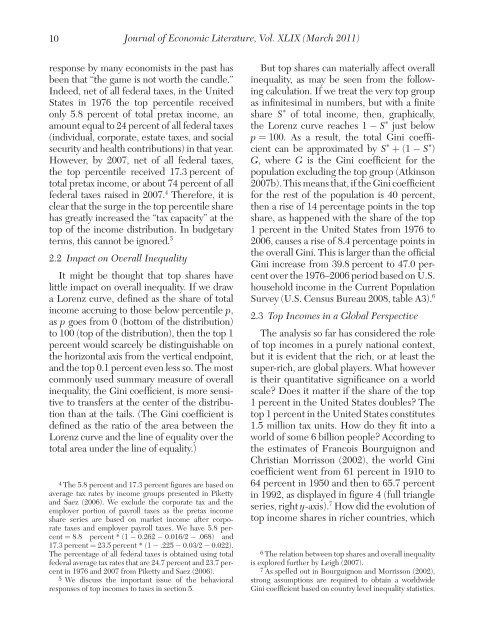"Top Incomes in the Long Run of History" with Tony Atkinson and
"Top Incomes in the Long Run of History" with Tony Atkinson and
"Top Incomes in the Long Run of History" with Tony Atkinson and
Create successful ePaper yourself
Turn your PDF publications into a flip-book with our unique Google optimized e-Paper software.
10Journal <strong>of</strong> Economic Literature, Vol. XLIX (March 2011)response by many economists <strong>in</strong> <strong>the</strong> past hasbeen that “<strong>the</strong> game is not worth <strong>the</strong> c<strong>and</strong>le.”Indeed, net <strong>of</strong> all federal taxes, <strong>in</strong> <strong>the</strong> UnitedStates <strong>in</strong> 1976 <strong>the</strong> top percentile receivedonly 5.8 percent <strong>of</strong> total pretax <strong>in</strong>come, anamount equal to 24 percent <strong>of</strong> all federal taxes(<strong>in</strong>dividual, corporate, estate taxes, <strong>and</strong> socialsecurity <strong>and</strong> health contributions) <strong>in</strong> that year.However, by 2007, net <strong>of</strong> all federal taxes,<strong>the</strong> top percentile received 17.3 percent <strong>of</strong>total pretax <strong>in</strong>come, or about 74 percent <strong>of</strong> allfederal taxes raised <strong>in</strong> 2007. 4 Therefore, it isclear that <strong>the</strong> surge <strong>in</strong> <strong>the</strong> top percentile sharehas greatly <strong>in</strong>creased <strong>the</strong> “tax capacity” at <strong>the</strong>top <strong>of</strong> <strong>the</strong> <strong>in</strong>come distribution. In budgetaryterms, this cannot be ignored. 52.2 Impact on Overall InequalityIt might be thought that top shares havelittle impact on overall <strong>in</strong>equality. If we drawa Lorenz curve, def<strong>in</strong>ed as <strong>the</strong> share <strong>of</strong> total<strong>in</strong>come accru<strong>in</strong>g to those below percentile p,as p goes from 0 (bottom <strong>of</strong> <strong>the</strong> distribution)to 100 (top <strong>of</strong> <strong>the</strong> distribution), <strong>the</strong>n <strong>the</strong> top 1percent would scarcely be dist<strong>in</strong>guishable on<strong>the</strong> horizontal axis from <strong>the</strong> vertical endpo<strong>in</strong>t,<strong>and</strong> <strong>the</strong> top 0.1 percent even less so. The mostcommonly used summary measure <strong>of</strong> overall<strong>in</strong>equality, <strong>the</strong> G<strong>in</strong>i coefficient, is more sensitiveto transfers at <strong>the</strong> center <strong>of</strong> <strong>the</strong> distributionthan at <strong>the</strong> tails. (The G<strong>in</strong>i coefficient isdef<strong>in</strong>ed as <strong>the</strong> ratio <strong>of</strong> <strong>the</strong> area between <strong>the</strong>Lorenz curve <strong>and</strong> <strong>the</strong> l<strong>in</strong>e <strong>of</strong> equality over <strong>the</strong>total area under <strong>the</strong> l<strong>in</strong>e <strong>of</strong> equality.)4 The 5.8 percent <strong>and</strong> 17.3 percent figures are based onaverage tax rates by <strong>in</strong>come groups presented <strong>in</strong> Piketty<strong>and</strong> Saez (2006). We exclude <strong>the</strong> corporate tax <strong>and</strong> <strong>the</strong>employer portion <strong>of</strong> payroll taxes as <strong>the</strong> pretax <strong>in</strong>comeshare series are based on market <strong>in</strong>come after corporatetaxes <strong>and</strong> employer payroll taxes. We have 5.8 percent= 8.8 percent * (1 − 0.262 − 0.016/2 − .068) <strong>and</strong>17.3 percent = 23.5 percent * (1 − .225 − 0.03/2 − 0.022).The percentage <strong>of</strong> all federal taxes is obta<strong>in</strong>ed us<strong>in</strong>g totalfederal average tax rates that are 24.7 percent <strong>and</strong> 23.7 percent<strong>in</strong> 1976 <strong>and</strong> 2007 from Piketty <strong>and</strong> Saez (2006).5 We discuss <strong>the</strong> important issue <strong>of</strong> <strong>the</strong> behavioralresponses <strong>of</strong> top <strong>in</strong>comes to taxes <strong>in</strong> section 5.But top shares can materially affect overall<strong>in</strong>equality, as may be seen from <strong>the</strong> follow<strong>in</strong>gcalculation. If we treat <strong>the</strong> very top groupas <strong>in</strong>f<strong>in</strong>itesimal <strong>in</strong> numbers, but <strong>with</strong> a f<strong>in</strong>iteshare S * <strong>of</strong> total <strong>in</strong>come, <strong>the</strong>n, graphically,<strong>the</strong> Lorenz curve reaches 1 − S * just belowp = 100. As a result, <strong>the</strong> total G<strong>in</strong>i coefficientcan be approximated by S * + (1 − S * )G, where G is <strong>the</strong> G<strong>in</strong>i coefficient for <strong>the</strong>population exclud<strong>in</strong>g <strong>the</strong> top group (Atk<strong>in</strong>son2007b). This means that, if <strong>the</strong> G<strong>in</strong>i coefficientfor <strong>the</strong> rest <strong>of</strong> <strong>the</strong> population is 40 percent,<strong>the</strong>n a rise <strong>of</strong> 14 percentage po<strong>in</strong>ts <strong>in</strong> <strong>the</strong> topshare, as happened <strong>with</strong> <strong>the</strong> share <strong>of</strong> <strong>the</strong> top1 percent <strong>in</strong> <strong>the</strong> United States from 1976 to2006, causes a rise <strong>of</strong> 8.4 percentage po<strong>in</strong>ts <strong>in</strong><strong>the</strong> overall G<strong>in</strong>i. This is larger than <strong>the</strong> <strong>of</strong>ficialG<strong>in</strong>i <strong>in</strong>crease from 39.8 percent to 47.0 percentover <strong>the</strong> 1976–2006 period based on U.S.household <strong>in</strong>come <strong>in</strong> <strong>the</strong> Current PopulationSurvey (U.S. Census Bureau 2008, table A3). 62.3 <strong>Top</strong> <strong>Incomes</strong> <strong>in</strong> a Global PerspectiveThe analysis so far has considered <strong>the</strong> role<strong>of</strong> top <strong>in</strong>comes <strong>in</strong> a purely national context,but it is evident that <strong>the</strong> rich, or at least <strong>the</strong>super-rich, are global players. What howeveris <strong>the</strong>ir quantitative significance on a worldscale? Does it matter if <strong>the</strong> share <strong>of</strong> <strong>the</strong> top1 percent <strong>in</strong> <strong>the</strong> United States doubles? Thetop 1 percent <strong>in</strong> <strong>the</strong> United States constitutes1.5 million tax units. How do <strong>the</strong>y fit <strong>in</strong>to aworld <strong>of</strong> some 6 billion people? Accord<strong>in</strong>g to<strong>the</strong> estimates <strong>of</strong> Francois Bourguignon <strong>and</strong>Christian Morrisson (2002), <strong>the</strong> world G<strong>in</strong>icoefficient went from 61 percent <strong>in</strong> 1910 to64 percent <strong>in</strong> 1950 <strong>and</strong> <strong>the</strong>n to 65.7 percent<strong>in</strong> 1992, as displayed <strong>in</strong> figure 4 (full triangleseries, right y-axis). 7 How did <strong>the</strong> evolution <strong>of</strong>top <strong>in</strong>come shares <strong>in</strong> richer countries, which6 The relation between top shares <strong>and</strong> overall <strong>in</strong>equalityis explored fur<strong>the</strong>r by Leigh (2007).7 As spelled out <strong>in</strong> Bourguignon <strong>and</strong> Morrisson (2002),strong assumptions are required to obta<strong>in</strong> a worldwideG<strong>in</strong>i coefficient based on country level <strong>in</strong>equality statistics.















